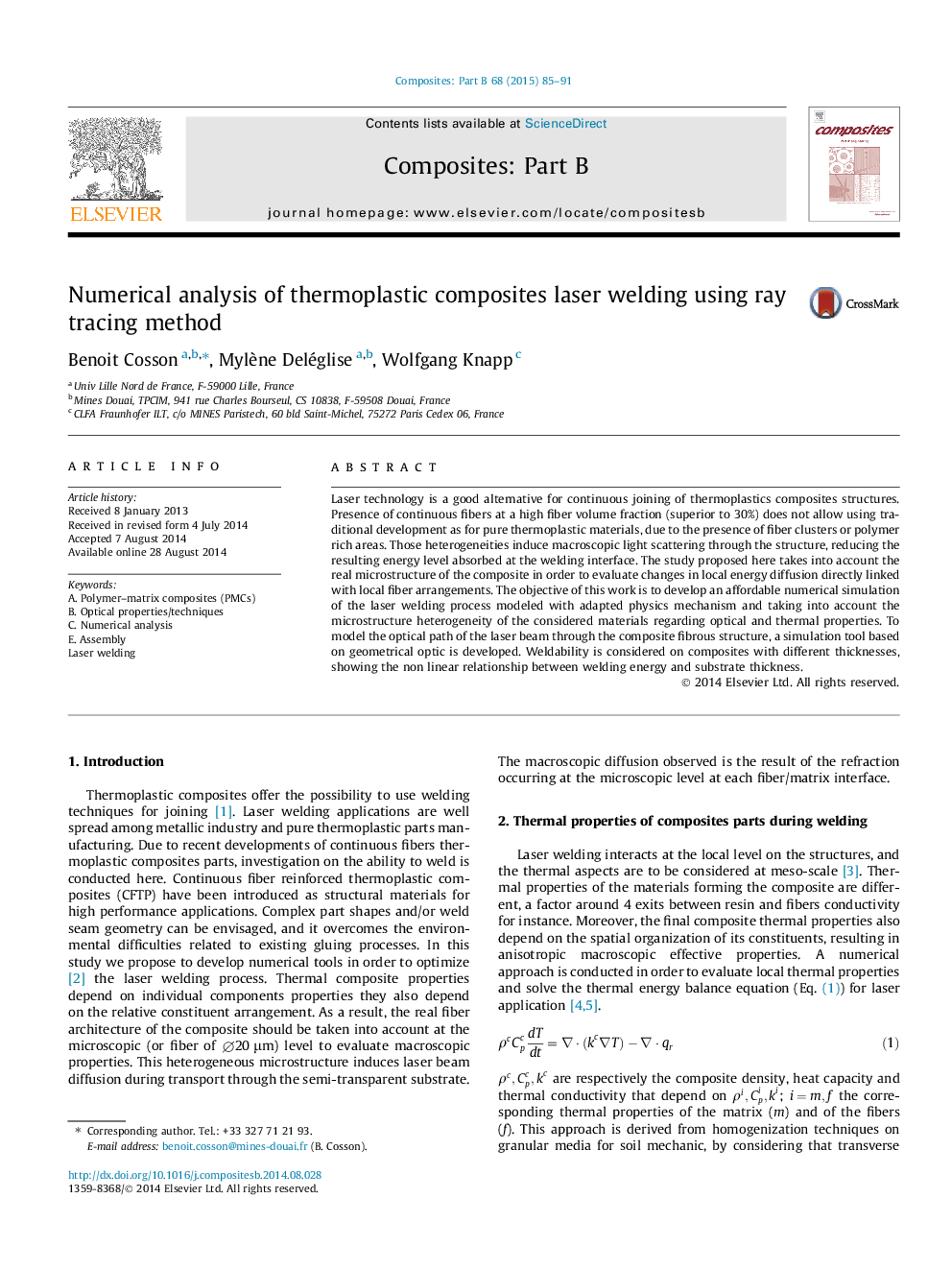| کد مقاله | کد نشریه | سال انتشار | مقاله انگلیسی | نسخه تمام متن |
|---|---|---|---|---|
| 7213181 | 1469417 | 2015 | 7 صفحه PDF | دانلود رایگان |
عنوان انگلیسی مقاله ISI
Numerical analysis of thermoplastic composites laser welding using ray tracing method
ترجمه فارسی عنوان
تجزیه و تحلیل عددی از جوشکاری لیزر کامپوزیت گرمانرم با استفاده از روش ردیابی اشعه
دانلود مقاله + سفارش ترجمه
دانلود مقاله ISI انگلیسی
رایگان برای ایرانیان
کلمات کلیدی
ترجمه چکیده
تکنولوژی لیزر یک جایگزین مناسب برای پیوند مداوم ساختارهای کامپوزیتی گرمانرم است. حضور فیبرهای مداوم در یک فیبر سرامیکی (بیش از 30٪) باعث عدم استفاده از محصولات سنتی به دلیل مواد خام ترموپلاستیک می شود، به دلیل حضور خوشه های فیبر یا مناطق غنی از پلیمر. این ناهمگونی ها باعث پراکندگی نور ماکروسکوپیک از طریق ساختار می شود و سطح انرژی حاصل شده در رابط جوشکاری را کاهش می دهد. مطالعات پیشنهاد شده در اینجا به ریز ساختار واقعی کامپوزیت به منظور بررسی تغییرات در انتشار انرژی محلی به طور مستقیم با ترتیبات فیبر محلی مواجه می شوند. هدف از این کار توسعه یک شبیه سازی عددی مقرون به صرفه از فرایند جوشکاری لیزر است که با مکانیزم فیزیکی اقتباس شده و با توجه به ناهمگنی ریزساختار مواد در نظر گرفته شده در خصوص خواص نوری و حرارتی، مورد توجه قرار گرفته است. برای مدل سازی مسیر نوری پرتو لیزر از طریق ساختار فیبرهای کامپوزیتی، یک ابزار شبیه سازی بر اساس نوری هندسی توسعه یافته است. جوش پذیری در کامپوزیت با ضخامت های مختلف در نظر گرفته شده است، نشان دهنده رابطه غیر خطی بین انرژی جوشکاری و ضخامت بستر است.
موضوعات مرتبط
مهندسی و علوم پایه
سایر رشته های مهندسی
مهندسی (عمومی)
چکیده انگلیسی
Laser technology is a good alternative for continuous joining of thermoplastics composites structures. Presence of continuous fibers at a high fiber volume fraction (superior to 30%) does not allow using traditional development as for pure thermoplastic materials, due to the presence of fiber clusters or polymer rich areas. Those heterogeneities induce macroscopic light scattering through the structure, reducing the resulting energy level absorbed at the welding interface. The study proposed here takes into account the real microstructure of the composite in order to evaluate changes in local energy diffusion directly linked with local fiber arrangements. The objective of this work is to develop an affordable numerical simulation of the laser welding process modeled with adapted physics mechanism and taking into account the microstructure heterogeneity of the considered materials regarding optical and thermal properties. To model the optical path of the laser beam through the composite fibrous structure, a simulation tool based on geometrical optic is developed. Weldability is considered on composites with different thicknesses, showing the non linear relationship between welding energy and substrate thickness.
ناشر
Database: Elsevier - ScienceDirect (ساینس دایرکت)
Journal: Composites Part B: Engineering - Volume 68, January 2015, Pages 85-91
Journal: Composites Part B: Engineering - Volume 68, January 2015, Pages 85-91
نویسندگان
Benoit Cosson, Mylène Deléglise, Wolfgang Knapp,
